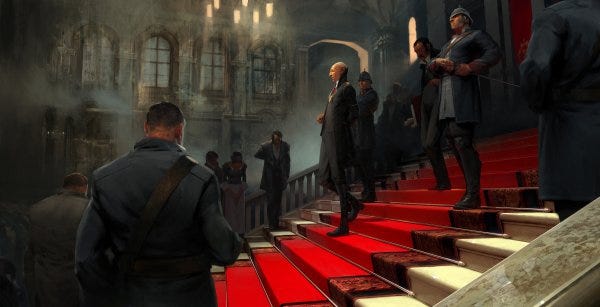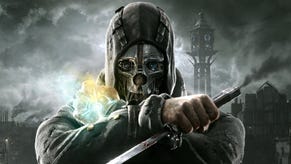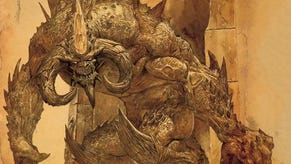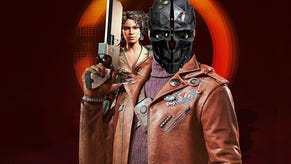Pondering Dishonored With Co-Lead Raf Colantonio
Through The Looking Glass
At last week's German mega-convention, GamesCom, I sat down for the second time to play Dishonored. This game of stealth, magic, and assassination will be one of the handful of truly important games in 2012, and whether or not it is entirely a success, its release and development will have been an important event in game design history. Read on for more thoughts on why that is, as well as words from the game's co-lead, Arkane creative boss Raf Colantonio, who I spoke to after my most recent session at the controls of super-assassin Corvo Atano.
Spoilers will be kept to a minimum.
I made a mistake when I was talking about Dishonored after my first encounter with it. I suggested that it is something like "Thief with a knife", but actually that's not fair on either Thief or Dishonored. The great victory of the Thief games was in making first-person stealth work, and in making players terrified of their own vulnerability. Above all else those games were about turning the conventions of the first-person genre inside out. But the same is not true of Dishonored, because this is a game of empowerment. While Corvo is indeed highly vulnerable to the guards and stilt-walking tall boys, he is actually more like a superhero: a supernatural Batman. This is a sort of limited power fantasy and probably has more in common with Deus Ex and the Hitman games than it does with Looking Glass' masterpiece.
That's not to say it wasn't influenced by the Looking Glass games: of course it was. Colantonio and colleague Harvey "Deus Ex" Smith, say as much. But the significance of Dishonored is that it is a sort of mature expression of those influences as well as many others. It's obviously trying to be a commercial hit - Bethesda are throwing a huge marketing budget behind it, and it arrives at a time when the console population is at its fullest for this generation - but it also represents a culmination of efforts for a very particular sort of game development studio: those influenced by simulationist, "immersive" tendencies, those who wish to give us tools and see us master and re-play, rather than simply experience a story. There are only ever a few of these sorts of games being developed at any one time, and they usually seem like a bit of a gamble. Dishonored doesn't seem like a gamble, and that alone is something significant.

The level I played at GamesCom was the same one that Nathan detailed by trying to break it over here. I won't go into much more detail, for spoiler's sake, but I will say that I marvelled at some of the richness of detail, and was overjoyed at the sort of Hitman-esque possibilities I discovered in its simulation-heavy approach.
And so back to my point. Having pondered the array of ways in which Corvo is more powerful than his adversaries - he can (unlocks and skill-tree permitting) bend time, possess people, teleport, and shoot them in the face with a pistol - I asked Colantonio whether he worried about delivering an unbalanced game when working with so many potentially emergent feature sets: "Of course we do worry so much about that," the Frenchman shrugged, "but we worry more about whether the player feels empowered and whether the game is fun. The first draft of any of the mechanics we came up with was perhaps a bit over-powered, but we were saying "this idea is going to be really powerful, and so really cool" and then we see how it works, and if that is too easy we'll find a way to make it a challenge. The most important thing is that we don't want it to be boring."
It isn't boring.

Something that had set me thinking, both in the Kelden's Bridge level, and the party-infiltration that I played in GamesCom, was the esoteric weirdness of the range of powers that Corvo could obtain. Stabbing people with a big knife, turning into a rat, telekinetic blasts - it's a range that doesn't seem to fit any particular thematic structure. Instead, it just makes the possible approaches to any given level hugely diverse. Taking out my target at the party could have have worked in a dozen ways that I could see, and more that I couldn't. Was this range of abilities, I asked Colantonio, written up from the outset? Was it set in stone by the fiction? Or was it some other evolution of design? How did Arkane decide what Corvo would be able to do? "Some of it is entirely abstracted at first," he nods, "like we just have an idea for a mechanic. But the art and design always feedback from one to the other. One department has an idea and then the other one makes something, pushes it back, and then the other says "cool, we could use that", so it's very much a collaboration."
Perhaps more interestingly, the creative director revealed that the feature set that we see in the current game is a crop from brainstormed over-abundance, which was later culled to make sure the game only contained the stronger ideas, as he explained: "We probably designed about 30% more than we are going to ship. Generally we come up with twenty ideas for a power for our character, then we are going to choose the best of those, and then finally we will choose the best of the best. There is some going back later, but it's very minimal."

Fresh from my experiences with infiltrating the aristocratic household, and having played with some of the possibilities, I suggested to Colantonio that for him as a designer, there must be deep rewards inherent in watching players learn and master the systems he imagined: "Yes. For us the satisfaction is to see players do things that we have never seen before. We are still seeing that now. In fact I just saw something like that a few moments ago out there [in the GamesCom press booth where journalists are playing the game] and I was like "okay, wow."" He continued: "This was one of the objectives of the project: to engage player creativity, to allow them to develop their own play style. When we see that happening for real, it feels really good."
The consequence of this overall approach is that Dishonored is not as predictable as so many other games seem to be, and this seems to extend to the fiction and the level design. I felt that one of the more stinging criticisms of Dishonored cyberpunk cousin, Deus Ex: Human Revolution, was that the level design was too contrived, too predictable: there was always an alternate route through air ducts, behind those boxes. Was this something that Arkane worried about? "Yes, totally," says Colantonio. "I mean we didn't want to be too formulaic, we want to make sure that we broke the pattern. We've shown three different demos so far, and each one of these has a very different feel. They're not the same kind of mission, sometimes it's an abduction, sometimes you don't know who the target is." And you can see this in the environments that the team are creating: while each one is a small, self-contained videogame level, there are secrets, and there are asides. Things that might happen, or could be ignored. Colantonio stresses again: "We want to break up the patterns."

One way that Arkane have tried to break the pattern is by taking on the architect of City 17, former Valve worldbuilder, Viktor Antonov. His influence, both spatially and tonally, is in strong evidence as I move around the world of Dishonored, and there's a big whiff of Half-Life 2 as we take to the soldier-policed streets. I asked Colantonio whether Antonov had changed the way Arkane worked. "It did, in a way," says the game designer, and the rest of his answer implies that Antonov has changed the way an entire industry works, too: "We started to change our production method on Dark Messiah, and then on The Crossing [an abandoned project for which Antonov designed an alternative Paris] we worked in a completely different way. The original way we did this was to send in the level designer, and then send in the artist, who would make their changes, painting the walls, adding the props and so on. Since Half-Life 2, though, there has been this trend towards totally amazing architecture that is mapped into the gameplay, and that feels really real."
Half-Life 2, then - a game world architected rather than simply designed - was a turning point that hooked into Arkane as well as their peers: "We tried from then on to try and get an architect into level design from the ground up, so that we really get this realistic, immersive environments. That means a lot to the player's experience." Colantonio described how architect, artist, and level designer, all now work together to create environments that are believably impressive, beautiful to behold, and functional to play.
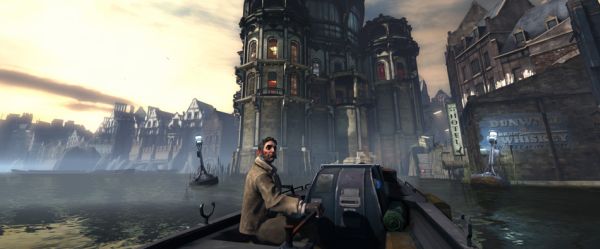
"We tend to ask the questions: What is the theme of this mission? How can it have its own identity? What vignettes take place? Then we let the level design and the architect work together." And as I played Dishonored's press-day levels, this approach was clear. It has been designed with enormous scope in mind: playgrounds for that weird range of powers that Corvo can potentially utilise. Shadowy paths to sneak in, yes, but also rooftops to teleport across, rat holes to run through, guard stations to walk a possessed grunt through: this is a game of variety. And I can hardly imagine the challenge that faced the Arkane team in making all that and still delivering on Antonov's meticulous city-building vision. Colantonio continued to explain it to me: "They will get given the objective, and it's really down to them how to organise that. And there are multiple paths, but it's not like we have discrete paths through a level, but more like we want the environment to be cohesive on the architectural side. Then later we need to look at other conditions, such as "make sure the guy who has blink can have fun", and "make sure the guy who has bend-time can have fun", etcetera. So it's very organic in the process, and a level can contain very specific structured things, which can come from anyone in the team. There's also a later phase, which is linking levels together, so that if a character survived in this mission, you will see him again in that mission. That sort of thing."
This richness will, I expect, be missed by some players. They will be the ones who are simply be gripped by that urge to simply get through the game as quickly as possible. But they shouldn't let that urge take over, because there is so much to miss. One such skippable vignette dominated the party level at GamesCom: an optional, formal duel with a masked aristocrat in the garden. I asked Colantonio if that being in the press level was just showing off, or whether it was truly representative of the game he was making. "There's quite a lot of those," he shrugs. "We think that these scenes make up like an additional 30%-40% of content that is optional. The difference between players to are very direct and don't care so much about the exploration, and the players who take the time to look at this stuff is pretty big."

That alone seems to speak of the kind of philosophy that Arkane have formulated from their diverse influences. From System Shock to Half-Life, from Deus Ex to Batman. But also something older, too, more classically videogamey: secrets for their own sake. Hidden caches, sliding doors, characters that don't have to be talked to in order to push the story along. It's a beautiful thing.
And yet, in spite of all this talk, the game's success is not a certainty. It looks strong, yes. It doesn't even feel like Bethesda are gambling on Arkane. But perhaps the game might falter as it leaves Arkane's doors. Perhaps the strange toolbox of powers might fail us, or the game might cough up unexpected horrors like Deus Ex's boss fights. Perhaps - a fate worse than being badly designed! - it might not sell. Regardless of those measures of success, though, I suspect that something else quite important is happening: Arkane are truly finding themselves. A giant, shared, psychic achievement is being unlocked in the making of the kind of game we asked for, and the kind of game that studio wanted to make.
I asked Colantonio whether this game had been the final objective in the latest arc of game development quest. Unfazed by silly metaphors, he nodded. "It has been a personal quest since we started Arkane, actually. Our biggest dream was to make games like that. If you look at the history of our studio you can see that have always been working on games that somehow share the same values: Arx Fatalis, Dark Messiah, we worked on Bioshock 2 also, and we have always looked to the Looking Glass games." He shrugs again, clearly over-familiar with explaining to an eager journalist exactly what he is doing here.
"Dishonored is the apex of that."
Dishonored arrives october 9th in North America and October 12th in Europe.
